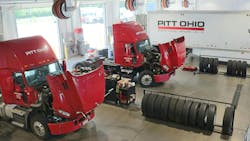This is Part Two of a two-part story. Click here to read Part One.
There can be many reasons for wanting to remodel or move to another shop. Not only can this allow managers and owners to redesign for maximum efficiency, but they can improve their technician retention strategies by making an environment that's more appealing to work in.
In Part One of this story, we discussed some of the hurdles of selecting a new location and designing a new shop. In Part Two, here's how to tailor your new space into one that your technicians are excited to work in every day, and how to coordinate the big move once construction is complete.
Purpose-built for workers
The goal of a facility refresh is to improve efficiency, as well as technician recruiting and retention.
“It’s all about work environment nowadays,” said Dan Carrano, VP of maintenance at A. Duie Pyle, an LTL carrier with 29 service centers throughout the Northeast, 23 of which have maintenance facilities. “Your shop has to be a place technicians want to go when they wake up in the morning.”
A. Duie Pyle has seen every version of the good, bad, and ugly over its 100 years in business. Now it has taken the best of the best to establish a gold standard that’s being applied to its maintenance facilities. Carrano refers to it as “Pyle-izing” shops.
There is quite a bit of Pyle-izing going on these days. Pyle acquired five Yellow properties in West Virginia, Pennsylvania, and New York late last year. “Any time you take over properties from a company that has filed bankruptcy, you know they have likely been neglected,” Carrano said.
Pyle’s facility maintenance department is in charge of getting the shell of a facility up to standard. Shops are professionally cleaned, repainted, and relit with LED lighting. HVAC systems are evaluated and updated as needed. Then Carrano and his maintenance team start to get involved.
“We put new air movement and oil systems in,” Carrano said. “We put in double-wall oil tanks, because we never trust existing tanks. Then we put in new tooling (i.e. lifts, jacks, alignment equipment, diagnostic tools, etc.). With those Yellow facilities we’ve acquired, we decided against bidding on the tooling because we like to go with standardized tooling across all our shops.”
Read more: Family-owned shop in Texas big on service, rich in history
Carrano has also developed some preferences to help improve the work environment. “We want a workplace that is clean and inviting,” Carrano said. “We don’t want our technicians to feel like they’re working in a cave.”
Coordinating a facility move
Something that can’t be overlooked when moving into a new facility is the logistical coordination of the move. It was quite the undertaking when Iron Buffalo switched Denver facilities over a weekend. The biggest key to pulling it off was establishing a point person.
“We had our general manager take over some of our service manager’s responsibilities so our service manager could completely focus on the coordination of our move,” said Austin White, co-owner of Iron Buffalo Truck & Trailer Repair. A second employee was assigned to function as the point person’s assistant. “Then we hired a third person to work with them,” White said. “We also hired four temporary employees through a labor agency.”
The point person planned what would happen each day of the move. The “moving team” was then responsible for loading trucks with equipment, parts, uniforms, and supplies to get it over to the new building. A specific time was arranged to transfer the technicians’ personal toolboxes, and each technician was responsible for loading and unloading (with assistance) their own toolbox.
A lot of prep work took place in the weeks leading up to the move. The shop interior got a brighter paint job. New office furniture purchased from an auction house was put in place. New shelving was installed and labeled. A week before the move, White had one of his technicians set up the lube system.
When the time came to actually move, White planned for a downtick in shop production and prepared his fleet customers accordingly. He said everyone was very understanding and, in most cases, very supportive. One customer even lent White four of their trailers.
After that brief production disruption, Iron Buffalo’s Denver team has been feeling the positive effects of the new facility and additional workspace. Now, the team in Kalispell is getting ready to start feeling those same positive effects in their new facility. It’s a considerably smaller shop, but it’s also a considerably smaller market. Regardless, the goals and expectations are the same.
“If you take good care of your technicians and help them become more efficient, they’ll take care of you,” White said.
Essential facility upgrades
Brighten things up
A Pyle-ized shop features a white ceiling and walls, aside from the bottom five feet, which is a lighter gray. Iron Buffalo has also switched to white, a stark contrast from the gray and blue that covered the walls when they moved into their new Denver facility.
Pitt Ohio recently refreshed its maintenance shop in Baltimore. Along with a brighter paint job and new LED lighting, Darakos said the facilities team worked to bring in as much natural light as possible. “The feedback has been very positive,” Darakos said. “I’ve even had some technicians jokingly tell me it’s almost too bright.”
Better breakrooms
At Pitt Ohio’s Baltimore shop, the facilities team took advantage of a spacious mezzanine to put in a table and comfortable seating, along with a fridge and microwave.
Pyle’s walled-off breakrooms also include kitchenettes with a fridge, microwave, and sink area. Windows provide natural lighting. A flat-screen TV broadcasts “Pyle TV” all day, giving technicians a chance to get caught up on maintenance bulletins and company news while they relax.
Comfort and convenience
Pitt Ohio and Pyle have both been putting in radiant heated floors. Additionally, Pyle’s shop floors are now ground smooth, as opposed to the more traditional porous concrete. A smooth floor won’t absorb chemicals and doesn’t need a sealer.
Pyle is also looking to add air conditioning to more of its shops, starting with those in southern markets. Their shop in Richmond, Virginia, which was built in 2022, is the first to have A/C.
“You’re going to start seeing more heavy-duty shops with air conditioning,” Carrano said. “A/C has been common in automotive shops for a while. It’s becoming necessary in our industry, too, in order to attract technicians with the skills needed to work on today’s heavy-duty vehicles.”
Also in response to today’s workforce realities, Darakos said Pitt Ohio has begun adding showers to bathrooms when feasible. Employees have been appreciative of this simple amenity when they have to scurry off to a personal event immediately after work.
Efficiency and safety
When Guzman Automotive built its shop less than a year ago, ideas on how to make things more efficient were welcomed from everybody.
“We’d originally wanted power outlets on columns toward the back of the shop,” Gonzales said. “But after hearing from our technicians, we realized it would be more efficient to run power outlets closer to each lift. Our builder agreed and said it wouldn’t be much of an expense, either.”
Guzman Automotive’s builder also came up with the idea to place all bulk fluid tanks outside. Fluids are pneumatically pumped into the shop through labeled faucets on the wall. Gonzales said this makes it easy for technicians, and also helps with fire code compliance because flammable liquids are stored away from any welding or grinding that’s taking place in the shop.
EV charging infrastructure
A new consideration for repair shops is EV charging infrastructure.
“For shops that are new to EVs, they might think of EV charging as just electricity and a bunch of plugs,” said Ryan Kennedy, founder of Atom Power, a provider of EV charging hardware and software solutions. “We look at EV infrastructure like an iceberg. The plug is just the tip of that iceberg you can see. Most of that iceberg, however, is under the water.”
To that point, the EV charging hardware itself typically represents just 20% of the total EV charging construction cost, according to Kennedy. While investing in good, reliable hardware is obviously important, partnering with a good, reliable provider is even more critical.
A good provider will become heavily engaged in the planning process early on, helping a shop ensure that it has the power availability necessary to have a reliable system installed. They will also possess both the internal capabilities and external partnerships to ensure a timely, quality installation and ongoing support. This kind of holistic approach, Kennedy said, is why Atom Power has been able to achieve a 99.6% uptime rating, which is far above the national average.
About the Author

Gregg Wartgow
Gregg Wartgow is a freelancer who Fleet Maintenance has relied upon for many years, writing about virtually any trucking topic. He lives in Brodhead, Wisconsin.

